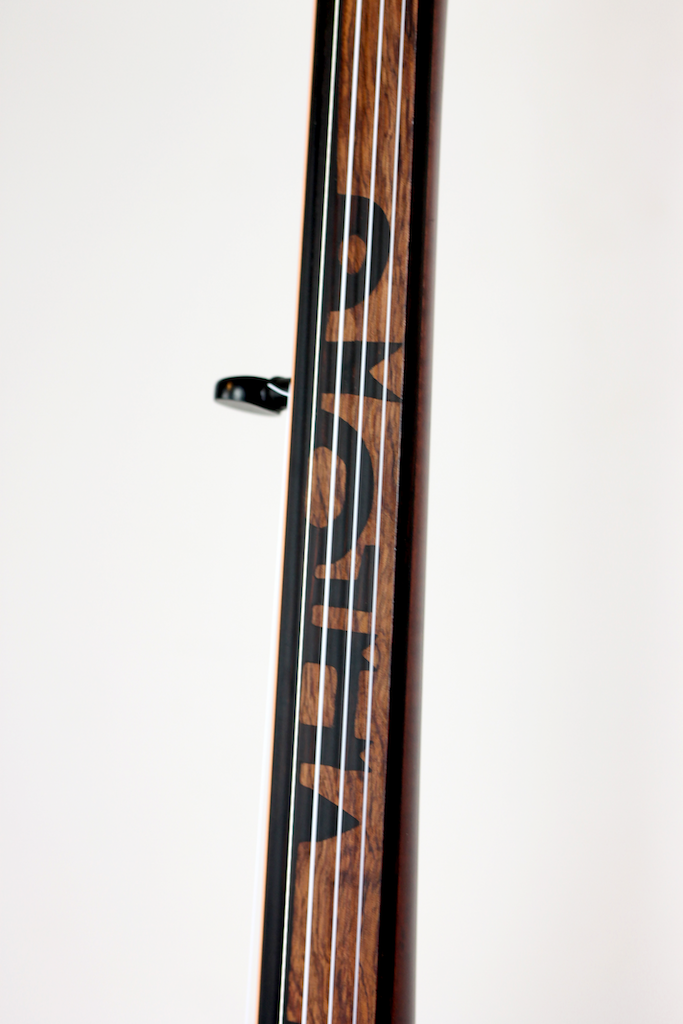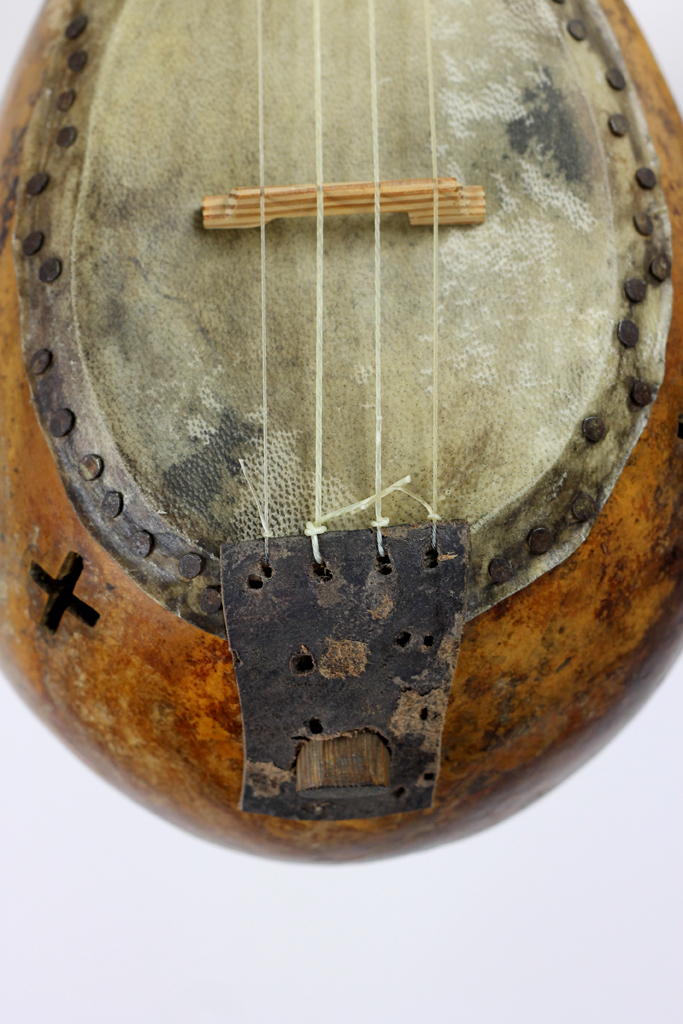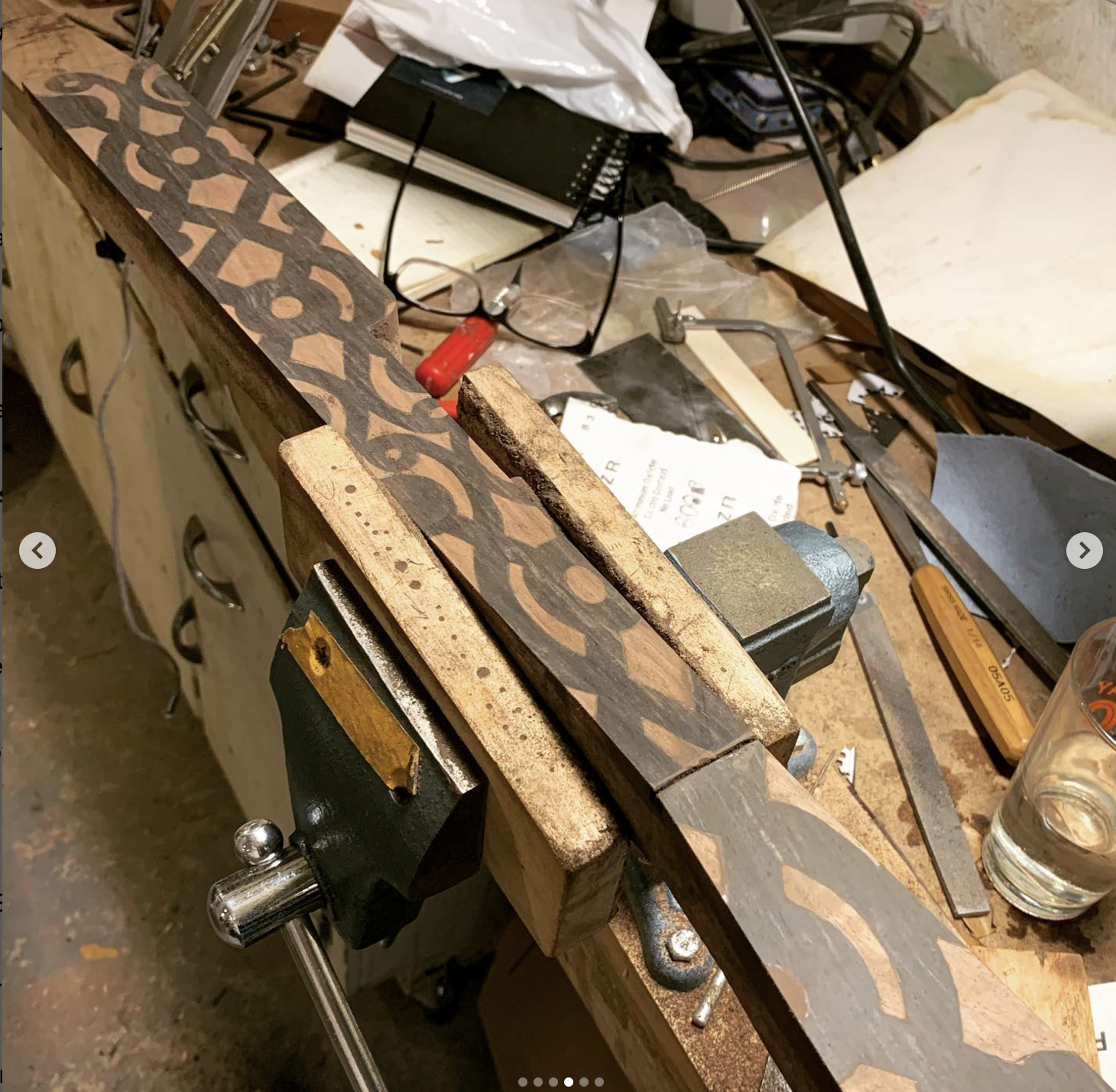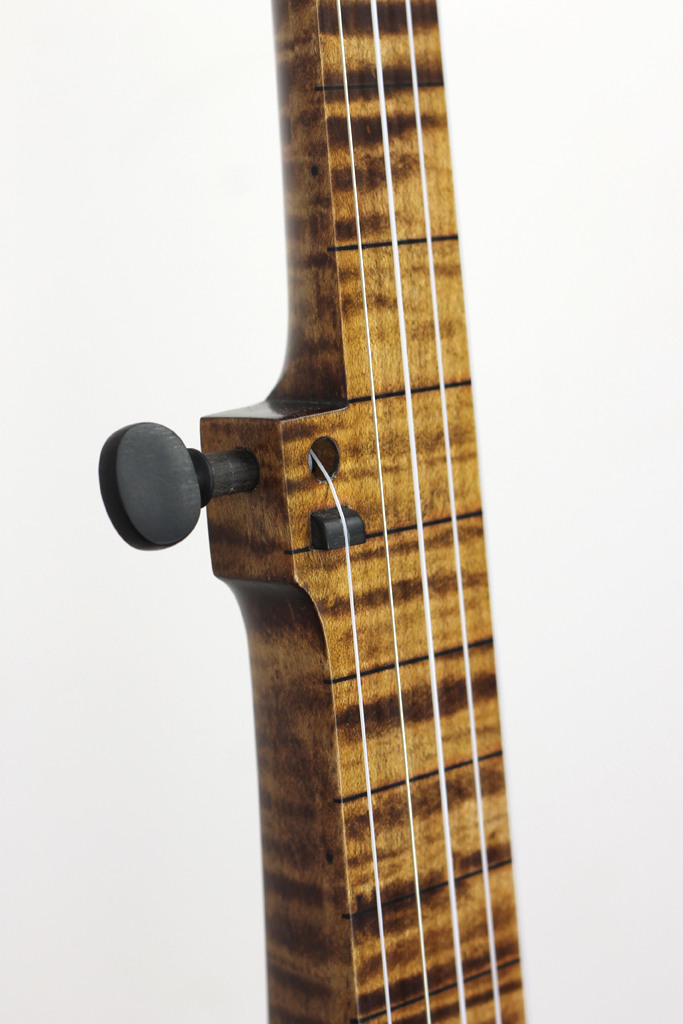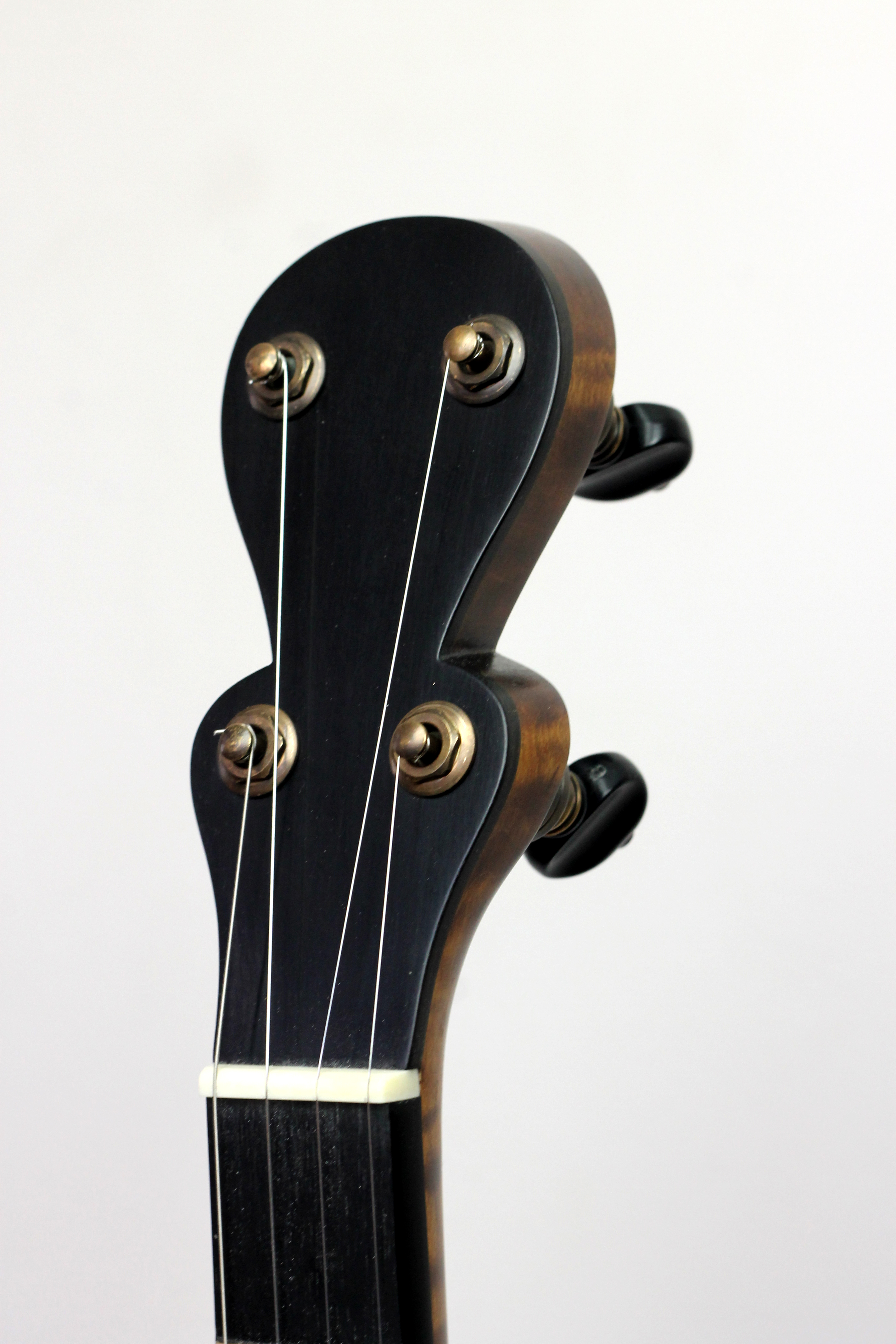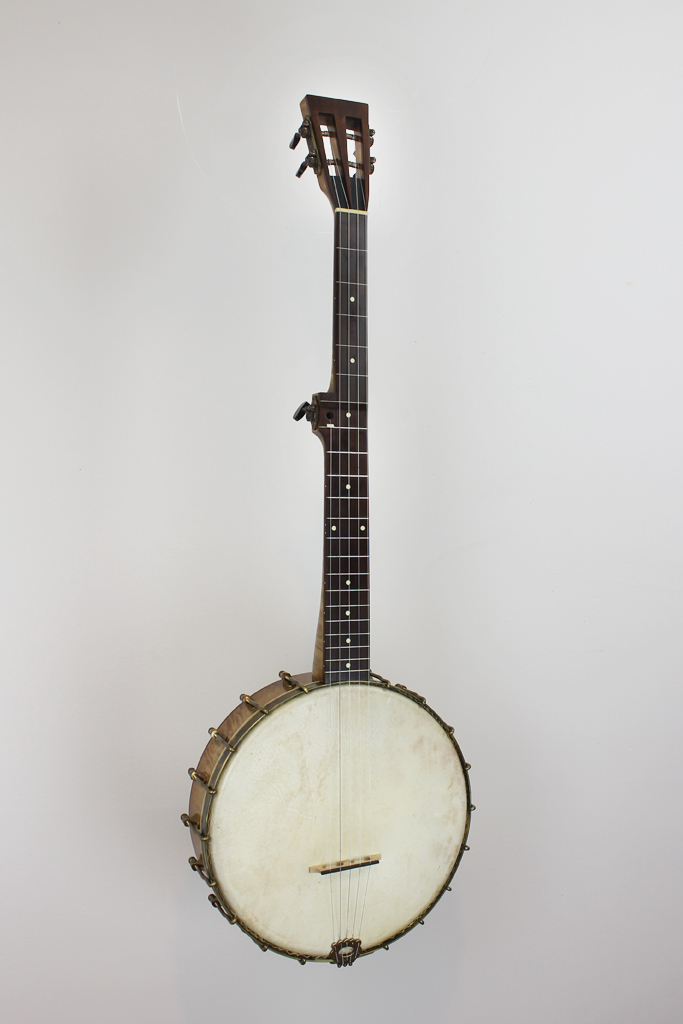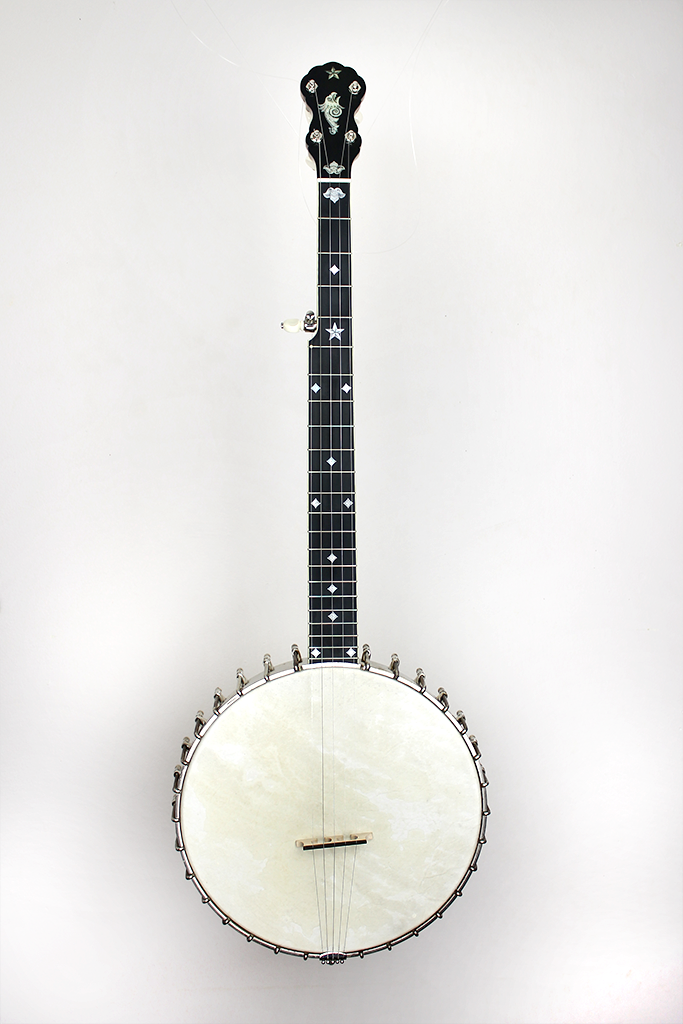Work samples
-
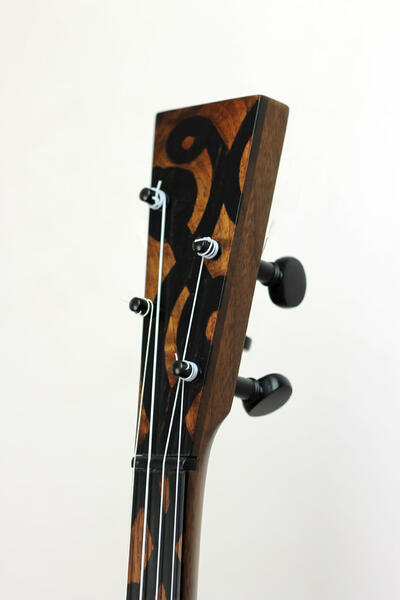 Surinamese-Inspired Gourd Banjo
Surinamese-Inspired Gourd BanjoA client wanted an instrument playable for contemporary hands but also wanted design elements that reference the instrument's earliest cultural history in the Caribbean and gave me free reign to create something. My mind quickly went to decorative elements from Surinamese art, a country that is home to two of the earliest surviving banjos. The black design is cut from a single, continuous piece of ebony and inlaid into walnut.
-
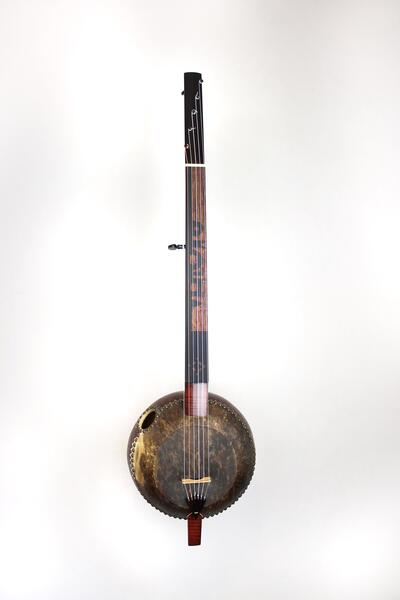 Jake Blount's Afro-Futurist Banjo
Jake Blount's Afro-Futurist BanjoMusician and scholar Jake Blount asked me to build him a six-string gourd banjo for a recording project. I worked with Jake to make an instrument that fit his specifications, but also made a physical manifestation of the Afro-futurist concepts that run throughout Jake’s work. The inlay is based on Kongolese regalia, while the overall form has developed over my decades of banjo building, and uses all natural materials and with aesthetic inspiration drawn from West African musical instruments.
-
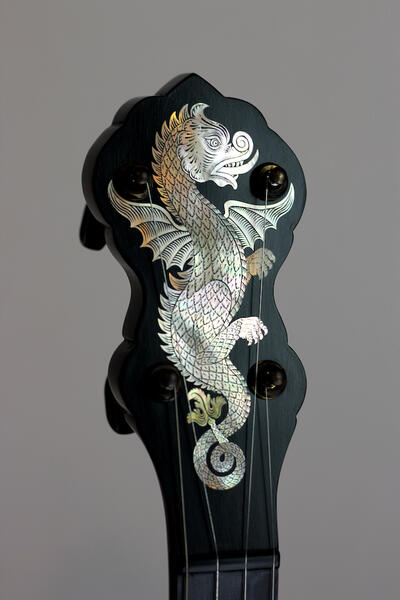 Dragon Engraving
Dragon EngravingIn addition to gourd banjos, I make banjos inspired by high-Victorian, late 19th century banjo makers. This dragon engraving is on the peghead of a banjo I finished in 2024. The engraving is modeled on the work of early 20th century master engraver Icilio Consalvi. His dragons appeared on a number of deluxe early 20th century banjos and is considered the high point of the era of highly ornate banjos. I studied all of his versions, and took the elements I liked the best to make this version. It was a real challenge and nerve-wracking at times but I was glad to prove my mettle.
-
Vienna School Gourd Banjo
This is the peghead from a really special gourd banjo I finished late 2023. The peghead, neck layout and inscribing, and overall feel is an homage to a gourd banjo that was in the Ruben Rubens collection in England, then got sold to a Japanese collector and finally ended up in the Hamamatsu City Museum in Japan. My tribute to it has a deep stained walnut neck and the peghead and fingerboard are curly walnut overlays and it has flush frets. The peghead is also a refined version of the "Vienna School" guitar pegheads of the mid-19th century. I also made the banjo a long scale length, and that with a big gourd gives it a nice robust bottom end.
About Pete
Pete Ross is a banjo maker, researcher, and musician who lives in Baltimore, Maryland. Since 1991, he has been trying to undo the cultural injustice of the banjo's relegation to the periphery of American culture. Through his instrument building, writing, and speaking, he has re-centered this African American instrument as an origin point of American popular culture. Although his wooden-rim banjos revisit the instrument's history of mass production, corner-cutting, bottom-line-motivated,… more
Jake Blount's Afro-Futurist Banjo
In 2023, I completed a custom instrument for musician and scholar Jake Blount. Working with Jake was fantastic because while his music is deeply influenced by historical material, he is addressing contemporary issues including climate collapse. As a maker who uses historical references but wants my instruments to be playable for modern musicians, I feel like I understood his vision. The result is a six-string gourd banjo with a longer scale length inspired by Kongo decorative elements and Jake’s personal aesthetics.
-
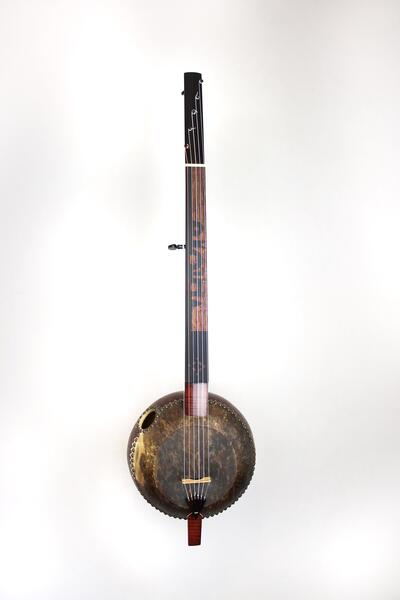 Afro-Futurist Gourd Banjo
Afro-Futurist Gourd BanjoJake wanted a six-string gourd banjo with a longer scale length to play deeper notes. The banjo has an extra string an octave below the 3rd string. It is strung with nylon strings and meant to be pitched at mid 19th century ranges. I set it up using the cFCEG, the tuning from an 1850 banjo primer.
-
 Fingerboard detail
Fingerboard detailThis fingerboard inlay is based on a cimpaba, a swords of Kongo regalia.
-
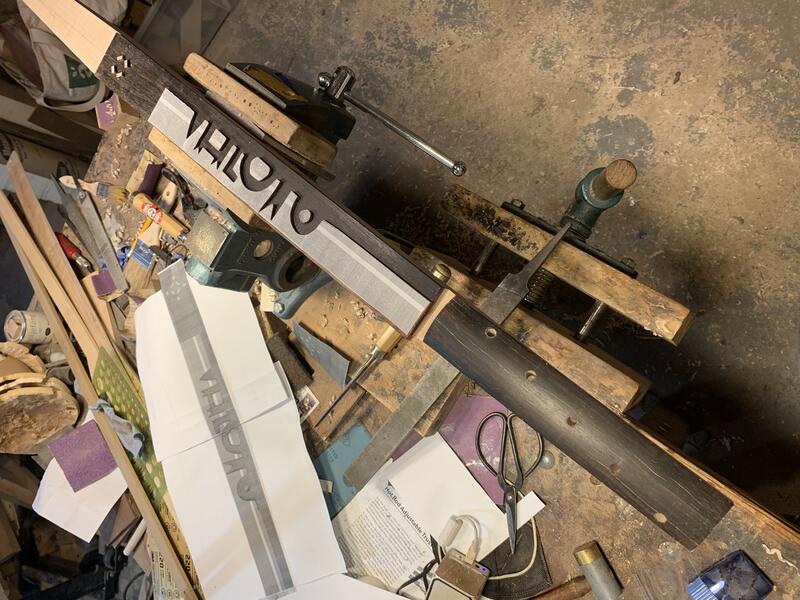 Inlay process
Inlay processTo accomplish the inlay, I drew up a full-scale pattern based on the image Jake had sent and glued it to the walnut fingerboard. I then routed out the pattern of the geometric shapes. I took the pattern of the geometric shapes and cut them out of a single piece of cherry (using a marquetry technique) and inlaid that into the walnut for the final design.
-
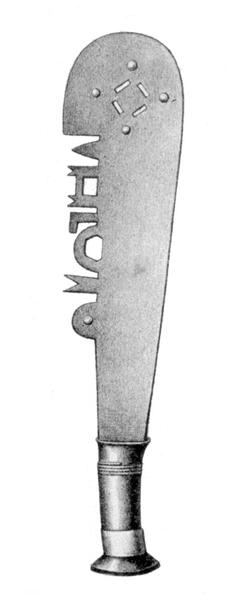 Inlay Inspiration
Inlay InspirationThis was the original inspiration Jake sent me. The cimbapa was a ritual knife used by rulers of the Kingdom of the Kongo, and Jake was drawn to it to reflect his African ancestry.
-
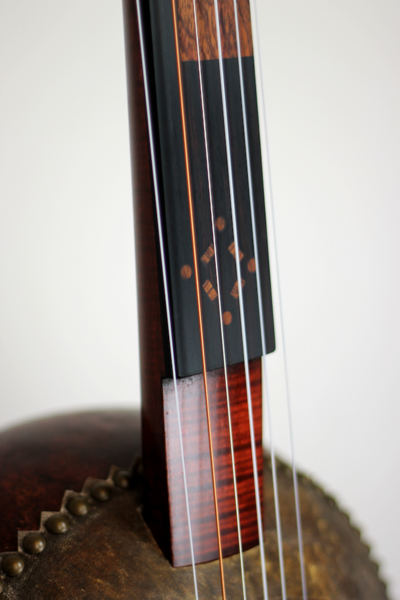 Second inlay
Second inlayThe second inlay pattern. Here you can see the red-dyed maple neck, as well as the walnut fingerboard and cherry inlay.
-
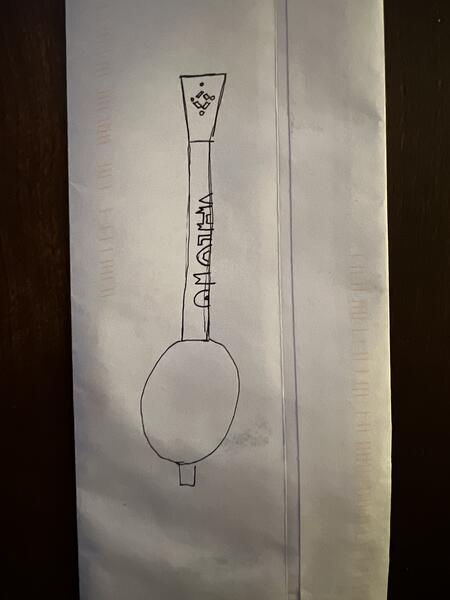 Rough sketch
Rough sketchA very rough sketch of Jake's banjo done on the back on an envelope after having an initial discussion with him. The drawing was refined and done at scale before I started the inlay.
-
Jake Blount & Mali Obomsawin feat. Joe Rainey - "My Way's Cloudy" (Official Music Video)
Jake Blount wanted the gourd banjo specifically for the album "symbiont," a collaboration with Native musician Mali Obomsawin. The instrument I built is featured in this song, which both explores climate change and narratives of African Americans from Virginia.
-
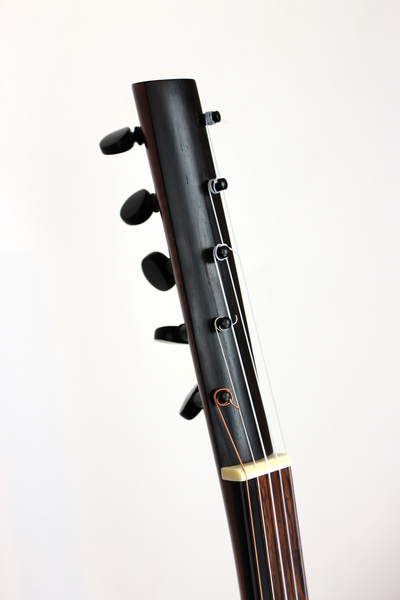 Peghead detail
Peghead detailBecause Jake wanted a peghead overlay but also wanted the peghead curved, I found an enjoyable challenge in steam bending ebony, something I had not done before.
-
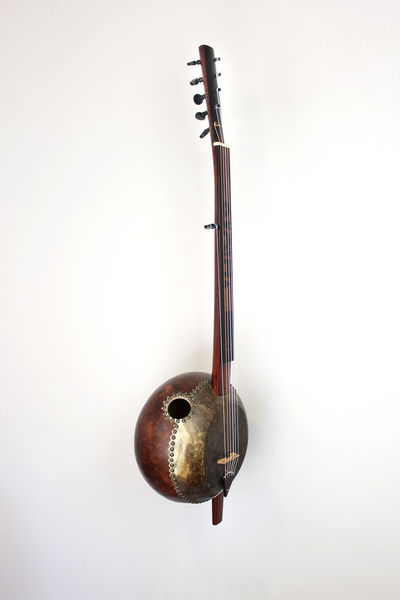 Side View
Side ViewAdding a sixth string was also an enjoyable challenge--banjos today typically have five strings. This required drawing a new pattern for the neck. I also made the scale length longer, per Jake's request.
-
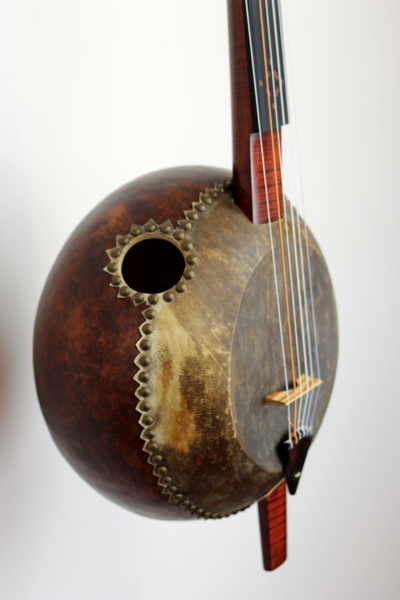 Gourd detail
Gourd detailBecause Jake wanted lower, richer tones on this instrument, I chose a large, round gourd. This would provide a deeper bottom end of notes without sacrificing the bright sound that comes when striking the strings.
Underground Railroad Banjo
In the spring of 2019, I was contacted by the prop master for the Amazon TV production of "The Underground Railroad," the Barry Jenkins adaptation of the novel by Colson Whitehead. They asked me for, among other things, a gourd banjo for a scene set on an 1850s Georgia plantation in the magical realist world of the novel. After talking with the prop master and the historical consultant, we decided I would build a banjo that combined elements from two early images and a surviving banjo that resembled these images, including the Hans Sloane from Jamaica (c. 1687-1707), a watercolor from South Carolina painted by a man named John Rose (c. 1785) and a gourd banjo collected in Haiti (c. 1851).
-
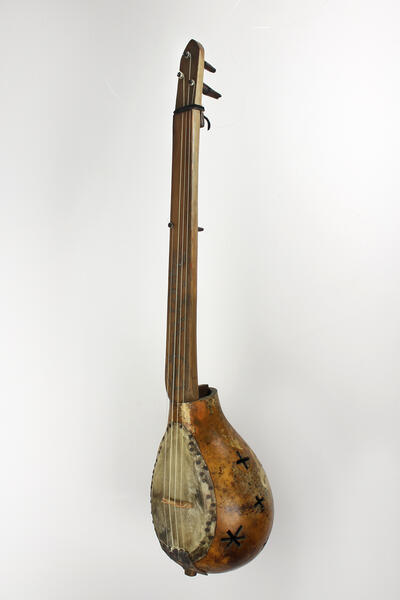 Underground Railroad Banjo
Underground Railroad BanjoAlthough inspired by historic instruments, we agreed to make some alterations to it that would make it easier to play for a modern musician, including making the fingerboard closer to the level of the skin head (called the action).
-
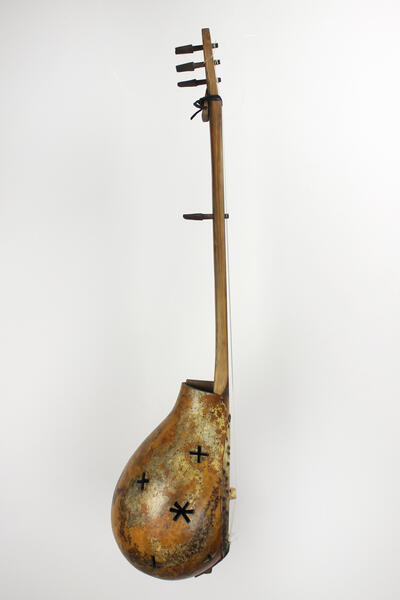 Side view
Side viewThe cross-shaped sound holes are a reference to a watercolor where enslaved people are depicted dancing, making music, and playing a gourd banjo. This cross is a reference to the crossroads of the living and the dead, a symbol appears often in danced religions of the African diaspora.
-
Haitian Banza
This banjo was collected in Haiti, but dates to before the Haitian Revolution. Like the watercolor from 1790s South Carolina, it has cross-shaped sound holes. I used it as an inspiration for this instrument. As I feel that my work is about representing the history of this instrument accurately and appropriately, I have traveled abroad to see all five extant gourd banjos. These banjos date from the 1780s to the 1850s, were collected in the Americas, and are now housed in European museums.
-
Neck detail
The instrument would also be an opportunity to show, as the prop master put it, "the spirit of Africanism within the slave quarters.” To that end I suggested the use of Gullah spiritual imagery, such as Ezekiel's Wheel at the bottom, on the fingerboard.
-
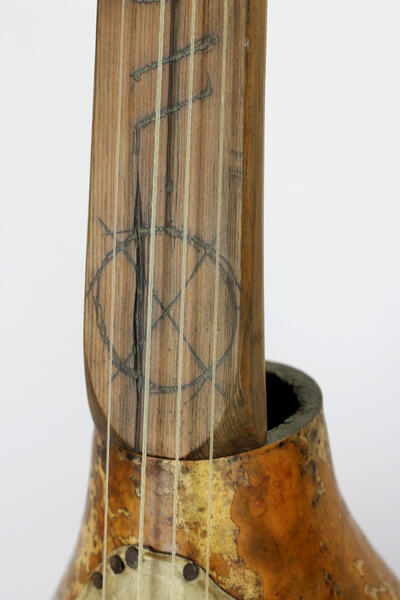 Neck detail
Neck detailLike the cross sound holes, the cosmogram/ Ezekiel's Wheel on the fingerboard is representative of the phases of life in African diasporic religions.
-
 Gourd detail
Gourd detailThis banjo needed to look well-worn and oft-played. To that end, I used leather for the tailpiece that I source from the cobbler at Colonial Williamsburg; left some skin on the gourd; painted sweat marks in watercolor on the skin head; and used lye to stain the fingerboard.
-
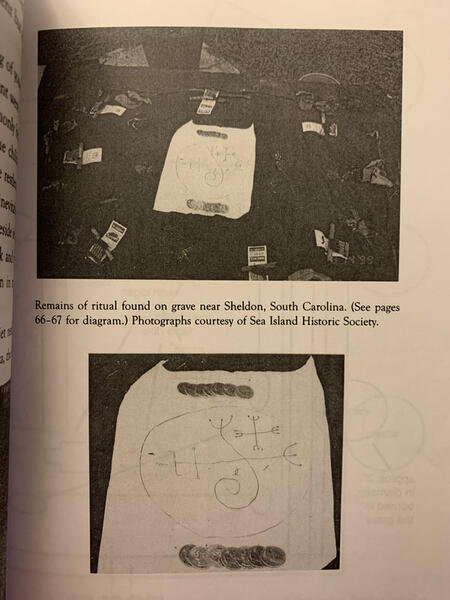 Carving inspiration
Carving inspirationImage of a drawing left on a grave in South Carolina, from Roger Pickney's "BLUE ROOTS: African American Folk Magic of the Gullah People," my inspiration for one of the carvings on the neck.
-
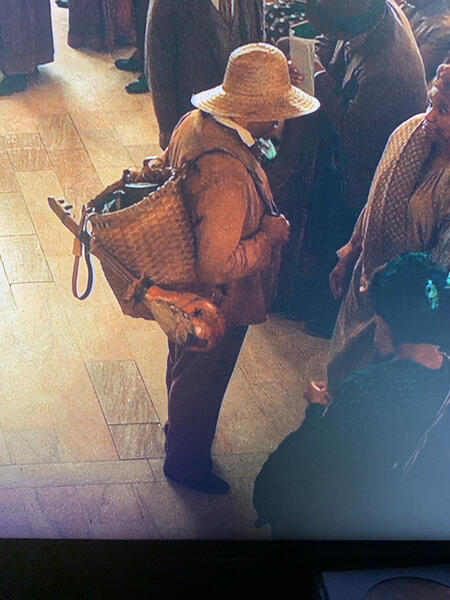 The banjo insitu
The banjo insituUnfortunately, the banjo was never actually played on screen but I was trilled to see it as a prop in Episode 8. Image courtesy Amazon/ Big Indie Underground Productions.
Modern Surinamese Gourd Banjo
A client gave me free range to create a modern gourd banjo inspired by two gourd banjos collected in the 18th and 19th century in Suriname. I wanted to combine the angular, hard-edged silhouette of mid-19th century North American banjos with the curvilinear forms of Surinamese decorative arts. Two of the oldest surviving early banjos from the African American tradition are from Suriname, and rely on spiritual decorations of the Surinamese Winti religion. I also wanted to contrast those decorative elements with the hard forms of the 1840s and 1850s commercially-made banjos from the United States.
-
 Modern Surinamese Gourd Banjo
Modern Surinamese Gourd BanjoThe banjo has a walnut neck with ebony inlay, a simplified 5th string peg, lightly dyed gourd with cosmograms etched in the gourd skin, and dark tacks.
-
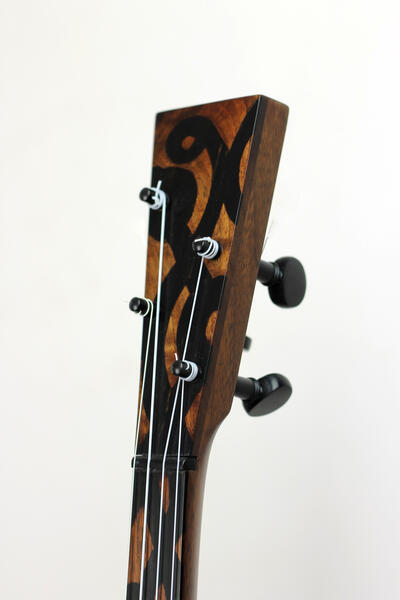 Detail of Peghead
Detail of PegheadI really love when clients come to me with a general idea of what they want (especially when it is an artistic concept I wouldn't think of myself) and then let me have free reign to create something I know they will love. This instrument allowed me to combine multiple eras of the instruments history through a visual representation.
-
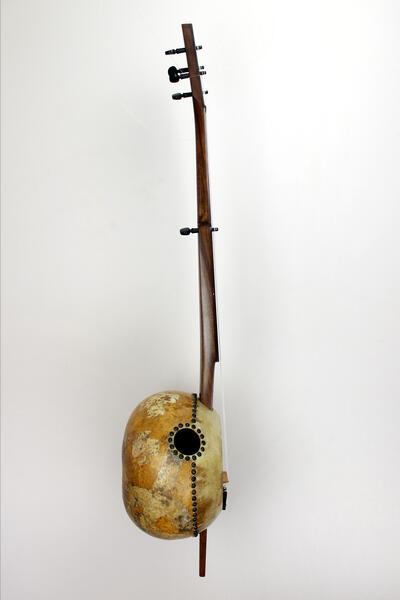 Modern Surinamese Gourd Banjo Side View
Modern Surinamese Gourd Banjo Side ViewInstruments like this that I build are not replicas of historic instruments, or even reimaginings of historic instruments. Instead (as you can see here), they are made playable for contemporary players who expect the strings to be close to the fingerboard for an ease of playing up the neck.
-
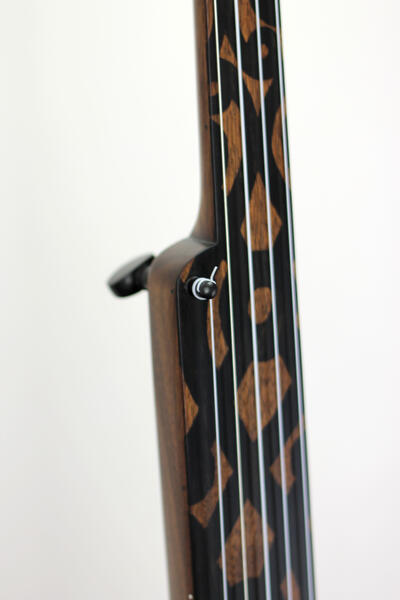 Fretboard detail
Fretboard detailThe inlay design is based on decorative arts from Surinamese Maroons, who escaped enslavement starting in the 1600s and formed communities in the jungle. I chose walnut with some figure for the fingerboard and peghead overlay. The inlay is cut from a single piece of ebony.
-
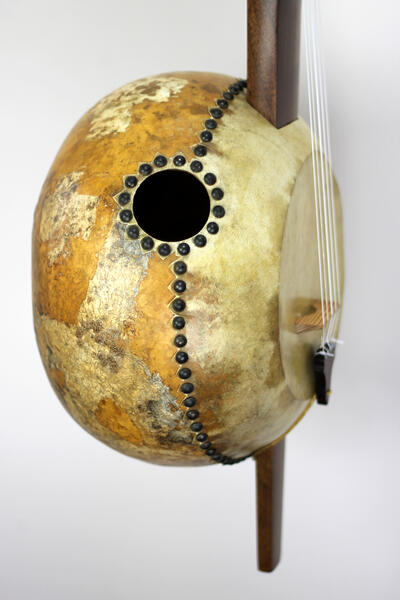 Detail of Gourd
Detail of GourdThe gourd also features subtle crosses etched from the gourd skin, referencing the crosses found on another surviving banjo collected in Haiti and dating from around 1790. These crosses symbolize the intersection of realms of the living and the dead.
-
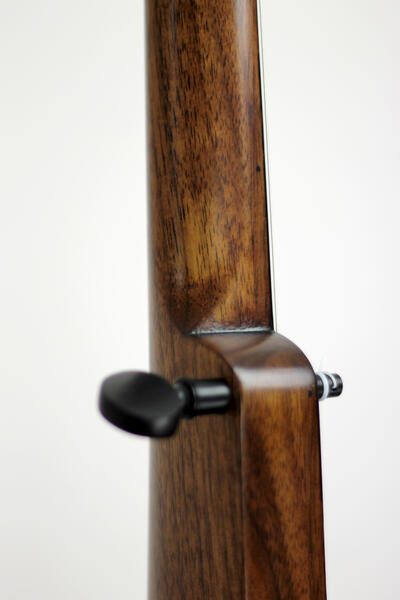 5th String Detail
5th String DetailI really loved using the simple lines of the silhouette of 19th-century American banjos combined with the curves of the Surinamese motifs.
-
 Inlay Process
Inlay ProcessTo achieve the inlay, I printed a full-scale image of the pattern and made various patterns (above the neck on the workbench). I glued one of the paper patterns to the surface of the ebony so that I could cut out the inlay, which was cut from a single piece of ebony using a jeweler's saw (visible on the workbench below the neck). I also used one of the patterns to determine what I needed to cut away from the neck using a router.
-
 Completed Inlay
Completed InlayOnce I had completed cutting out the inlay and routing out the pocket it would go into, I dry fit them together before glueing the piece of ebony into the walnut. I then sanded the fingerboard flat and applied finish to the entire neck.
-
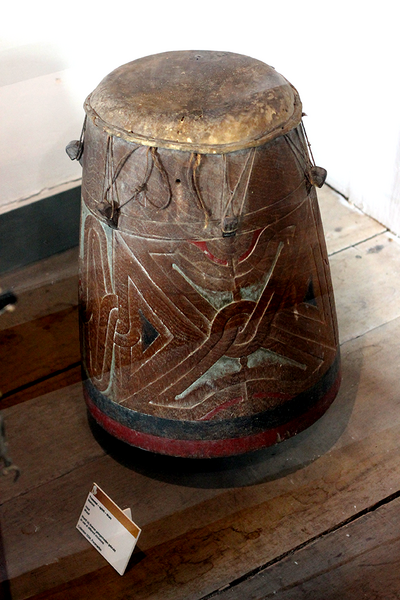 Surinamese Maroon Drum
Surinamese Maroon DrumIn 2018, I was lucky enough to travel to Suriname for banjo research. At one of the museums and in a Maroon village, I was struck with the curvilinear forms of their decorative arts. When I am out in the world, I am looking at elements of decorative arts and considering how I might use them in a banjo commission.
Vienna School Gourd Banjo
This is a really special gourd banjo inspired by historic instruments, but refined to suit my aesthetics. The peghead, neck layout and inscribing, and overall feel is an homage to a gourd banjo that was in the collection of a British man named Ruben Rubens. He sold it to a Japanese banjo collector and it is now at the Hamamatsu City Museum in Japan. The original is one of three pre-1900 gourd banjos that I don’t think are from the African American tradition. However, I haven’t seen in person yet but desperately want to, since seeing an instrument up close always reveals new things. My tribute to it has a deep stained walnut neck and the peghead and fingerboard are curly walnut overlays and it has flush frets. I also made it a long scale length, and that with a big gourd gives it a nice robust bottom end.
-
Peghead Detail
I thought I would orient the peghead like the historic banjo now in Japan, but I liked how it looked like the "Vienna School" 1830s guitar peg heads from C.F. Martin (who immigrated to the United States) and Johann Georg Stauffer.
-
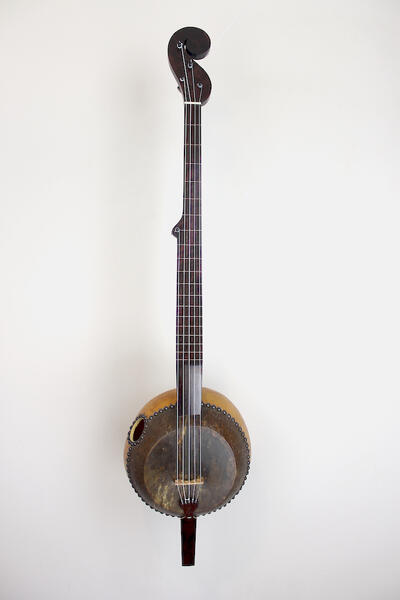 Vienna School Banjo
Vienna School BanjoAlthough it was a lot of work to create this new design, it is always fun for me to work from historic instruments and images and bring my own aesthetic to them.
-
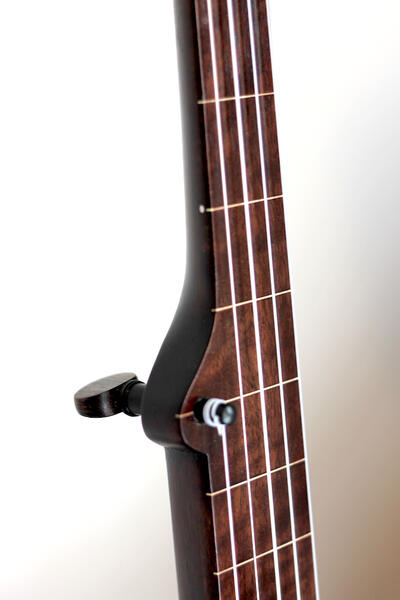 Fingerboard detail
Fingerboard detailThe fingerboard is highly figured, but also has frets that are flush with the wood. This allows the player to see where they need to put down their fingers but allows them to add slides.
-
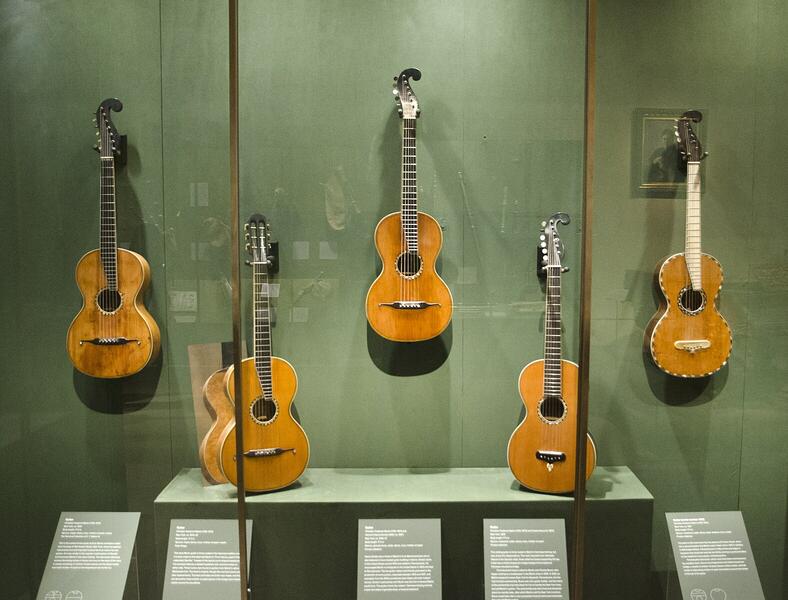 Guitar Inspiration
Guitar InspirationA photograph from "Early American Guitars: The Instruments of C. F. Martin" at the Metropolitan Museum of Art. These are the guitars that inspired me to redesign the peg head. The earliest commercial banjo manufacturer Willam Boucher, Jr. was like C.F. Martin an immigrant from Germany, and I've always felt that Boucher knew of this style of guitar and it perhaps influenced his peg head designs for banjos. My design is not exactly like either, but feels like it could have come from the same school.
-
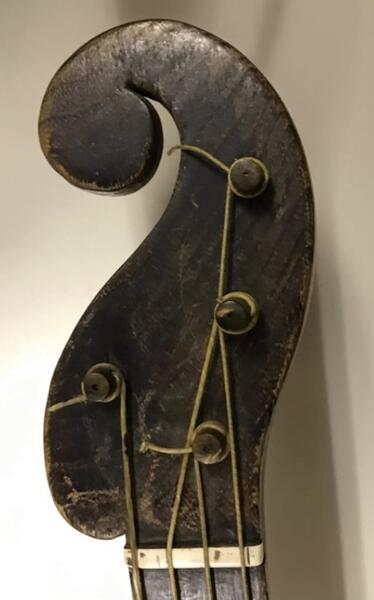 Original peghead
Original pegheadThis is the peg head for the instrument that inspired mine. The design is also similar to images of early commercial banjos found on 1840s sheet music.
-
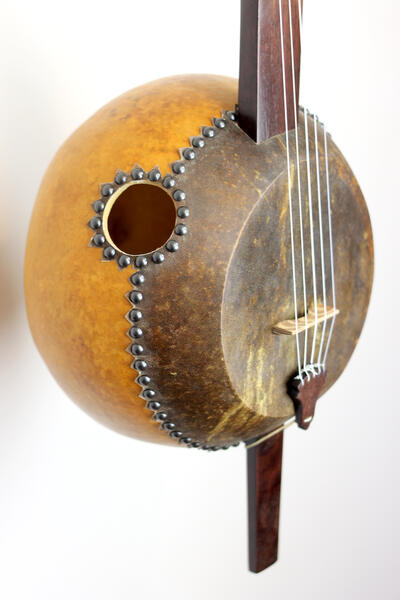 Gourd detail
Gourd detailI also made it a long scale length, and that with a big gourd gives it a nice robust bottom end. The gourd is lightly stained and sealed, and the skin is a dark goatskin with black tacks holding it to the gourd.
-
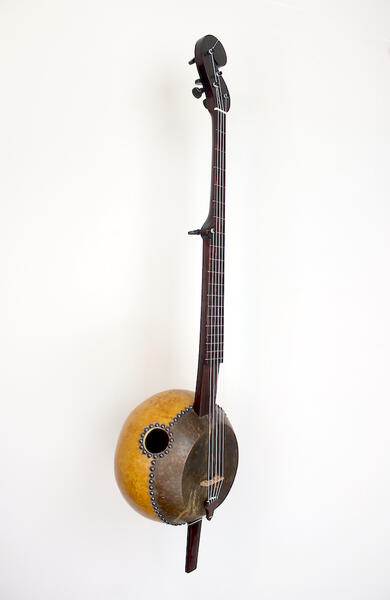 Side View
Side ViewI was truly pleased to again combine my interests as a historian with my practice as an artist and craftsman to bring this banjo to life.
-
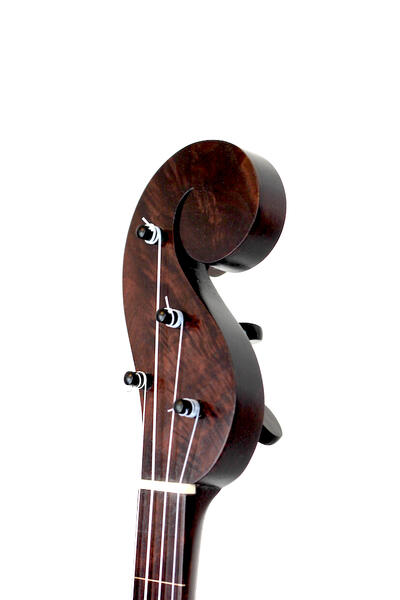 Peghead detail
Peghead detailAnother view of the peghead, taken from a three quarter view where the staining of the maple overlay on the peghead is very visible. I like the rich reddish brown stain.
1850s Banjos
After the advent of Blackface Minstrelsy in the 1840s, instrument makers began to manufacture banjos for a growing audience of white, secular musicians. The banjo transformed from a gourd-bodied spiritual device played by African Americans to a wooden-rim prop of the Minstrel Show. These new banjos needed to be easier to make, and were designed for the stage. Whereas gourd banjos were usually only heard on forced labor camps played by African Americans, these instruments were heard across the United States, and even in Australia, England, and Japan when it opened to the west. Today, I make wooden rim banjos based on designs from the late 1840s through the 1850s, with single-ply rims, less hardware, no tone ring. As always, I elevate the design using my own aesthetics.
-
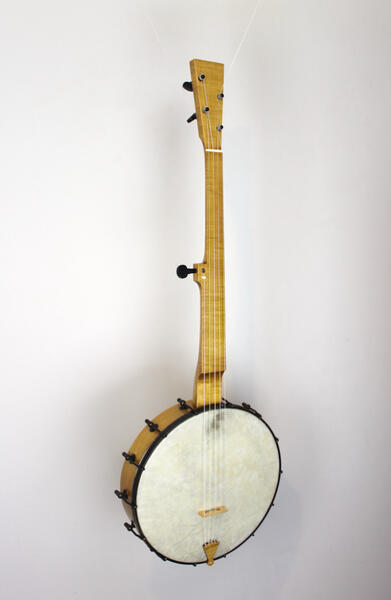 Working Musician’s Banjo From c1852
Working Musician’s Banjo From c1852One of my latest commissions ended up being the banjo I wished I had 32 years ago when I started learning 1850s banjo repertoire and playing techniques. The idea behind the instrument was to make a working musician’s banjo from c1852– nothing fancy, capturing the period but a workhorse of an instrument. The client and I worked from a series of period banjos and images of period banjos.
-
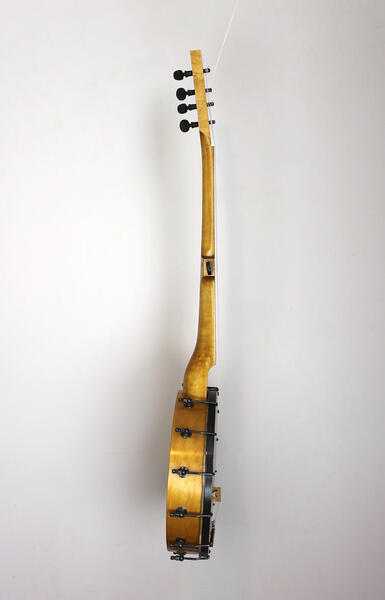 Working Musician’s Banjo From c1852 Side View
Working Musician’s Banjo From c1852 Side ViewThis wooden-rim banjo was made to aesthetically match a c1850s instrument that was plain, off-the-shelf of a music store. As with all the antebellum rim banjos I’ve made, whatever the aesthetic I’ve used the scale length and bridge placement of the 1850s Ashborn banjos, which I find to be among the best constructed and best sounding banjos of that era.
-
Working Musician’s Banjo From c1852 - Rim Detail
My customer wanted plain maple and a light stain, though a little curl in the wood still peeks through. The hardware is beautifully made by Brooks Masten — although the hardware is modeled after a little later time period, it is too nice not to use. The later hex style nut rather than the earlier square nuts (which brooks also makes) will allow my client to more easily maintain the head tension with a bracket wrench.
-
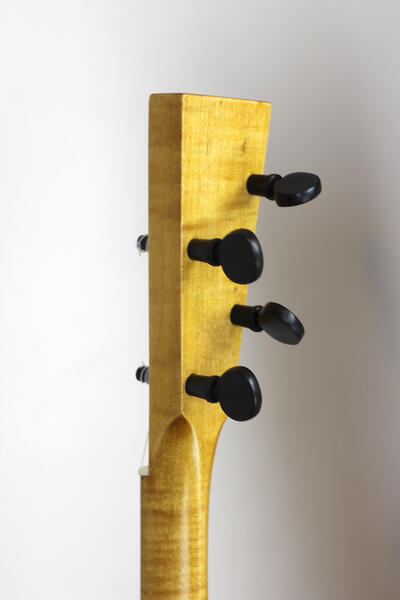 Working Musician’s Banjo From c1852 Peghead Detail
Working Musician’s Banjo From c1852 Peghead DetailIt has a paddle peghead I first saw on 1850s sheet music, and I love the simplicity of it and the boldness of the square top,
-
Playing the Working Musician's Banjo
The piece I’m playing is known by many titles but the version found in Dan Emmett’s personal manuscript is “Pea Patch Jig.” My playing is a little stiff here because I haven’t played it in a couple years. When I learned it many years ago it was the hardest piece I played because although it is downstroke, it isn’t like clawhammer/ frailing and uses triplets, dotted notes, syncopation etc etc
-
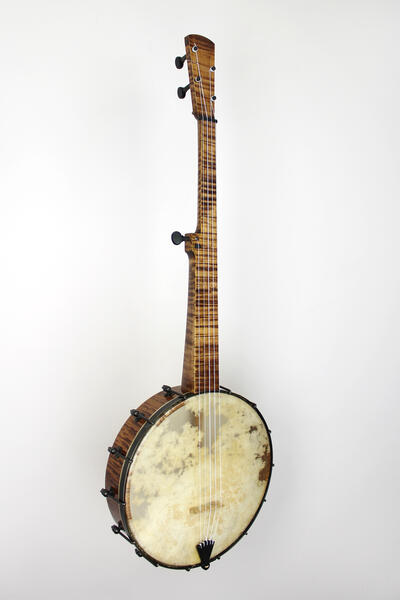 Duigood Banjo
Duigood BanjoDetail shots of my recent mid-19th century style build. Like banjos of that era, the rim is a deep, single ply and steam bent, 12” in this case. I based the scale length and bridge placement on Ashborn banjos, the best sounding and most competently made banjos of that period. Beyond those historical specs, I’ve added more modern elements of neck angle for improved string height (1/8” at the 12th fret) flush frets, and a graphite truss rod for added stability and rigidity. These are elements I’ve wanted to add for a while to antebellum style banjos as the complex arrangements of the period seem to call for it. As with my gourd banjos I also aspire to make instruments with the earlier tonality that you can bring any banjo repertoire to.
I modeled this on an 1850s banjo that was built in the D.P. Diuguid cabinet shop—the client was descended from an employee of the shop, so this was very special for him!
-
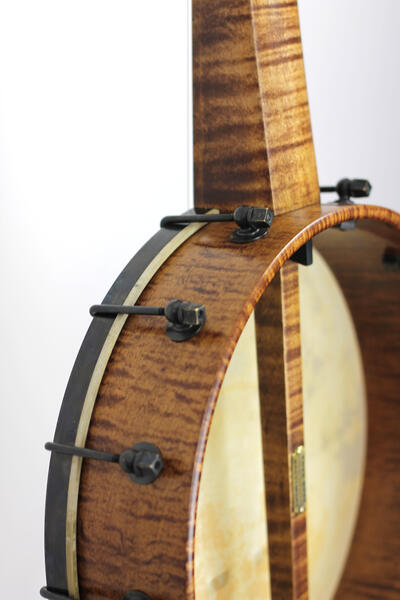 Diuguid Detail of the Rim
Diuguid Detail of the RimI double patinated the raw brass hardware (including the Brooks Masten bracket shoes I really love) resulting in a black with dark brown highlights color, custom ebony tuning pegs, tailpiece and wedge along with black, buffalo horn nuts.
-
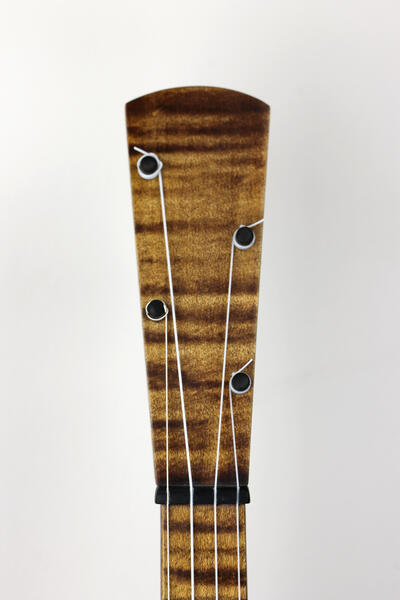 Diuguid Peghead
Diuguid PegheadI further narrowed the rectangular peghead with staggered pegs I’d used in the past to make it more like the Diuguid banjo. I love this simple peghead design that seems to disappear before the end of the 19th century
-
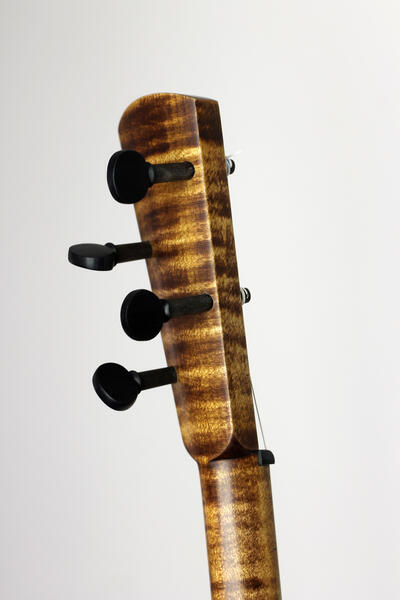 Diuguid Peghead - Back
Diuguid Peghead - BackThe back of the Diuguid banjo has an unusual but beautiful radius to it, which I’ve emulated. The peghead also abruptly narrows with “shoulders” just above the nut. I’ve neatened this up a little, drawing from 1830s guitars that have a similar feature.
-
 Diuguid Neck Detail
Diuguid Neck DetailThe original Diuguid is unusual for an early banjo in having clear attribution, and it’s also unusual in its form. The neck seems to be turned on a lathe, the pot is small, with a head on both sides—perhaps emulating a gourd. I really enjoyed making this refined version of it with flush frets in black material and matching hardware.
The Workman's Banjo
After Blackface Minstrelsy made the banjo a commercial object, makers began mass manufacturing the instrument. This sped up during the industrial revolution, and while some banjos got fancy (like the Victorian ones below), some were simply instruments to be played. Using instruments from the 1850s through 1880s as models, I've refined designs to essentially make what I say is a banjo that would have been made by "factory worker of the month." My instrument is clearly a reference to these mass produced ones, but I've taken the care to make them as nice as possible (although still plain).
The mass produced banjos shouldn't be lost in the instrument's history, either. In America, we've come to realize that the foundations of our culture did come from the hands of people--rural and urban--who could only afford a 75 cent mail-order instrument. These people made music, recorded it, and changed the sound of America.
-
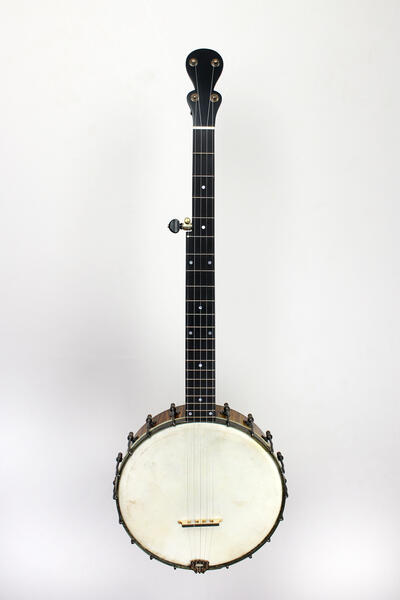 Catalog Banjo
Catalog BanjoThe aesthetic concept behind this banjo's design was to imagine the banjo that would’ve been ordered from a catalog in the early 20th century and delivered to a rural town, like the former lumber mill town of Elkins, WV where my client and friend Doug Van Gundy lives. Two banjos, ordered as the same item in, say, 1903 could end up pretty wildly different from each other so we were imagining this one as a banjo where everything added up just right, the piece of wood was a nice one, and the finish had just a little more time spent on it—all as if some dude at the Bronx, NY Buckbee factory was shooting for employee of the month.
-
 Catalog Banjo Peghead
Catalog Banjo PegheadAn example of one of these original banjos, also probably “accidentally nice” came through Kevin Enoch's banjo shop for repairs and I traced the peghead and held onto that for years waiting for an opportunity like this. I had to modify it a little bit for geared tuners. Along with those tuners another anachronism is Rocktite, an engineered wood I used instead of ebony for the fingerboard and overlays.
-
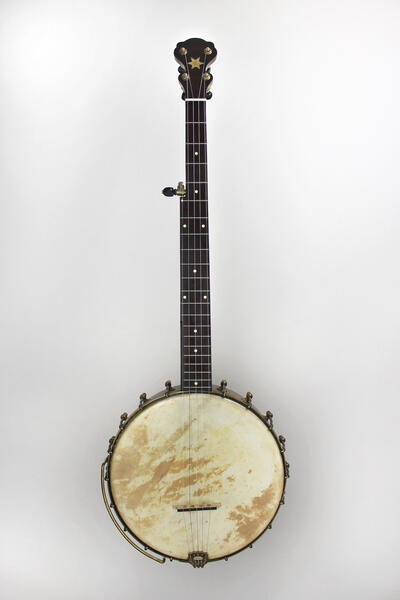 Cubly Peghead Style
Cubly Peghead StyleThis banjo is my homage to the banjos of the Dobson era, ca. 1880, including that first patented tone ring from Dobson, but adding some aesthetic elements from other builders from the same time that I’ve long admired. I've also included elements of my own I’ve had in mind for a while, and “modernizations” like neck angle, low action and geared tuners for the contemporary player.
-
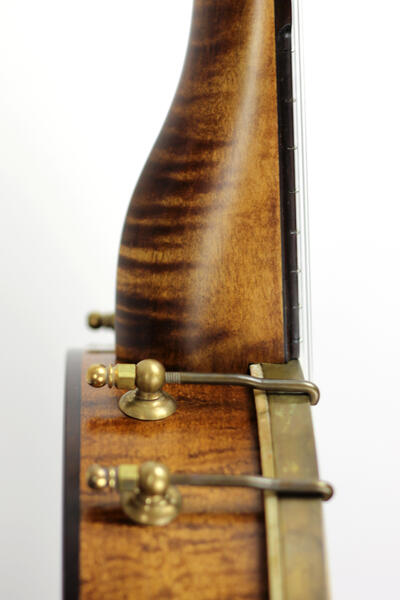 Neck Joint
Neck JointThe rim and neck are both curly maple with a slight antique tobacco stain. I was particularly pleased with the tight joint where the neck meets the rim. The tension hoop (at left) is hand-riveted by me, but the hardware comes from my friend and fellow banjo maker Brooks Masten.
-
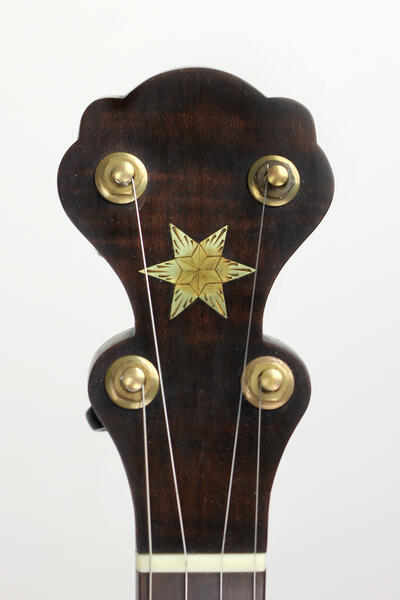 Cubly Peghead
Cubly PegheadI wanted these to be a little fancier than the Catalog Banjo I made my friend Doug. As such, I used a modified peghead shape found of "New York School" banjos of the 1860s and 1870s, some by a manufacturer named Cubly. I also added a brass star inlay, with a little engraving. The overlay on the peghead is a torrified maple, adding to the antiqued look.
-
Darker Cubly Style
This is similar to the Cubly style banjo, but the client wanted the rim painted black and a fretless ebony fingerboard.
-
 My Own Banjo
My Own BanjoThere's a saying that the cobbler doesn't have any shoes. All of the instruments I make go out the door to clients, and the only other banjo I've made myself was a gourd banjo 25 years ago. But this was a banjo that I had been imagining for years, and even kind of building in my head. In 2020, I finally had the chance to build it. My goal in making this was twofold; one was having a half fretless so I could better emulate the playing of Nathan Frazier, and two, to incorporate a lot of the detail of the early banjos whose aesthetics I love. This is a aesthetic blend of early industrial banjos (1875-1885), along with romance-era guitars (c. 1830s) some of whose details ended up on early Ashborn guitars and banjos. Finally, although these elements are from 19th century instruments, I wanted a banjo that would play 20th century pitches with steel stings. I had some of the parts made in a Baltimore foundry to emulate the generic 1880s form, used by Buckbee, Stewart and others.
-
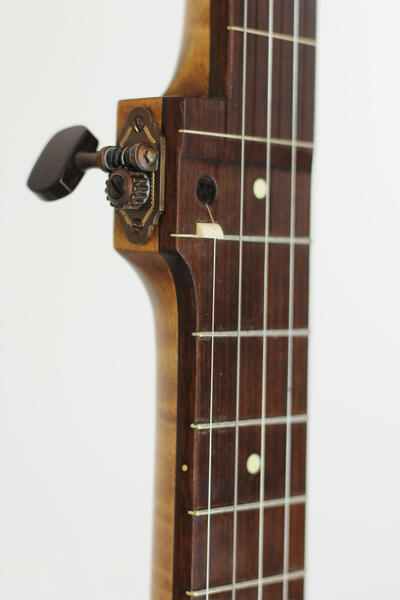 5th String Detail
5th String DetailThe fingerboard and various overlays are baked maple, to resemble the rosewood used in 1870s and ‘80s banjos. Everything else is curly maple with an amber/tobacco stain. The fifth string arrangement is based from 19th century banjo maker, Levi Brown, though similar set ups are common in the period.
-
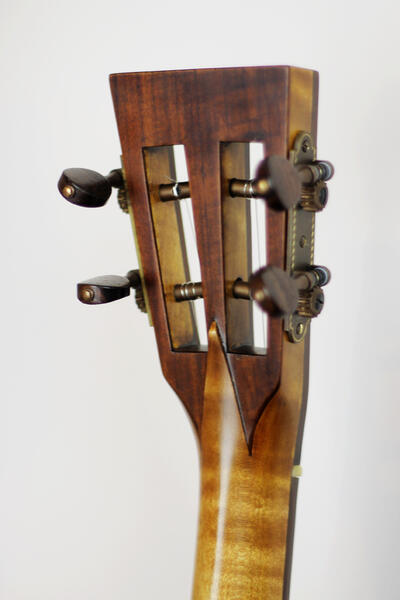 Back of the Peghead
Back of the PegheadA detail of the back of the slotted peghead.
-
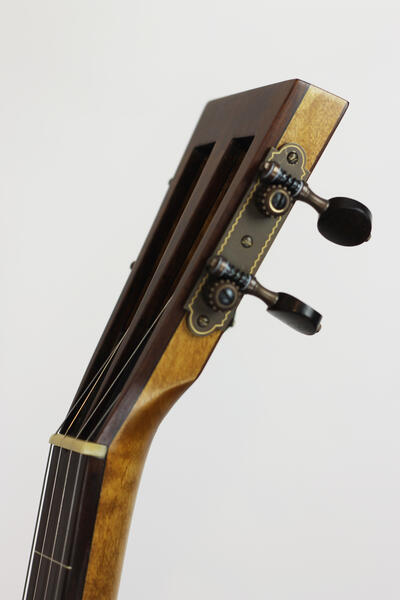 Another peghead view
Another peghead viewThis has a nice view of the peghead overlay.
High Victorian Banjos
In addition to gourd banjos, I make instruments inspired by wooden rim instruments of the late 19th and early 20th century. Beginning in the 1880s, banjo makers caught on to crazy of High Victorian decorative arts, which collided with banjo players wanting to "elevate" the instrument and play classical and contemporary melodies on the instrument. The result is highly ornate inlays and engravings, carved pegheads, and bright metal parts. These are some of my recent banjos of which I am the most proud.
-
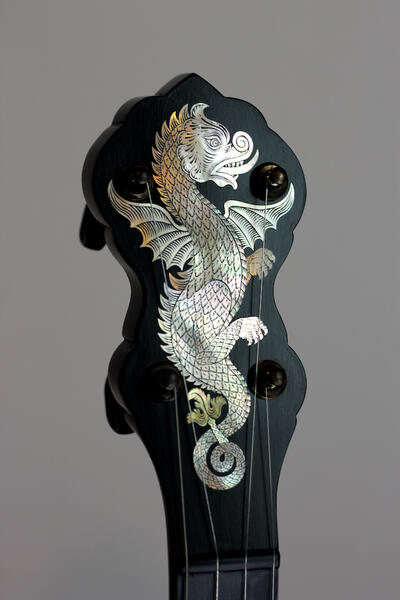 The Consalvi Dragon
The Consalvi DragonI worked for three weeks on this engraving, which included a lot of practice and laying out the design so I could feel confident about putting into the final (there’s no erasing or going back once you’ve made a choice in shell). I’m really pleased with how it turned out. I used originals made by master engraver Icilio Consalvi as inspiration, but I took the elements from his best work and added my own aesthetic to make this dragon engraving my own.
-
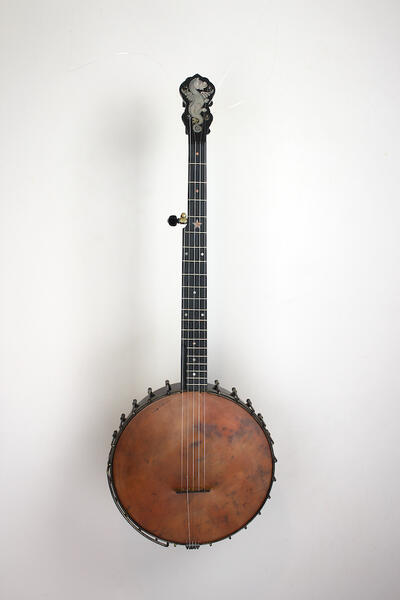 The Dragon Banjo
The Dragon BanjoWith the Consalvi dragon, this banjo is heavily influenced by the Boston banjos of the late 19th to early 20th century. But my client wanted to go for an otherwise stripped down banjo and a more “death rock” palate, so we chose dark stains on curly maple, dark “tortoise” binding, unplated dark brass hardware with a patina. And instead of the normally elaborate fingerboard inlays that would accompany the dragon, we went for simple dots and a star in black abalone. I love collaborating with clients like this, brining their ideas and my historical aesthetics together. This really activates the more creative parts of my luthiery.
-
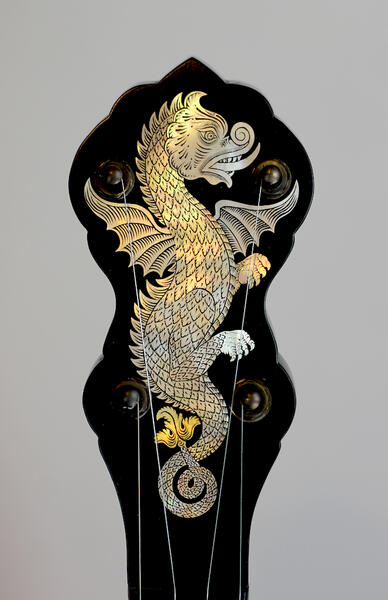 Another view of the dragon
Another view of the dragonI loved how my practices looked in comparison to one of Consavli’s. The late banjo maker Ed Britt discovered that certain Fairbanks, Cole, and Bacon banjos clearly were engraved by the same person, and when collector/ historian Jim Bollman bought a toolbox and unfinished inlays from Consalvi’s granddaughter, we were able to attach a name to the artwork.
I’m very lucky to have friends who can send me photos of their banjos or banjos they’ve worked on. The banjo I’m working on is original creation made in collaboration with my client rather than a strict recreation. Like all my instruments, it draws from historical sources so I gather as much period material as I can to inspire my work.
-
 Classic Era Banjo
Classic Era BanjoA client approached me with the wooden rim ("pot") of a historic banjo the manufacturer named Whyte Laydie No. 7 and asked me to make a reproduction of the neck. I’ve been engraving for years since my apprenticeship with Kevin Enoch but somehow I’ve never had a client to ask me to do these two classic,1890s Fairbanks designs. I loved being able to give the old pot a new life, and a client a historic-looking instrument.
-
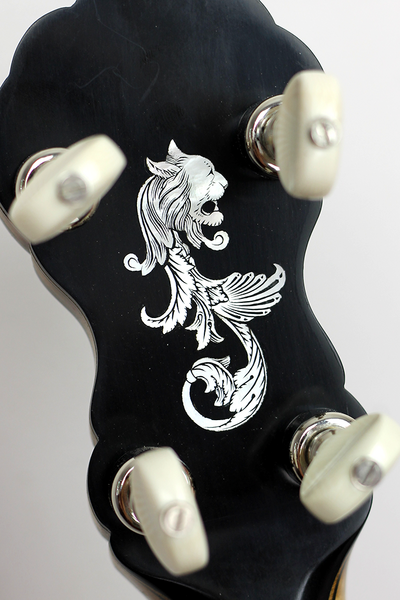 Lion Head Inlay
Lion Head InlayFor the lion head I actually went off on my own a fair bit because this design was used pretty early, before engraving on Fairbanks banjos really took off. I used an original basic outline and without much alteration in engraving it ends up actually looking like a lion!
-
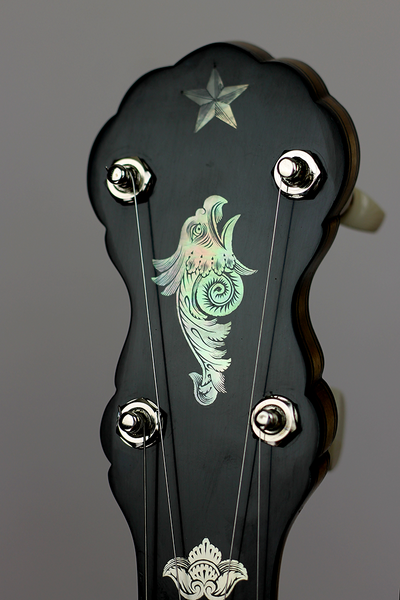 Griffin Inlay and Engraving
Griffin Inlay and EngravingI was able to pick my favorite elements from the various “griffin heads” I have pictures of and combine them into this one inlay.
-
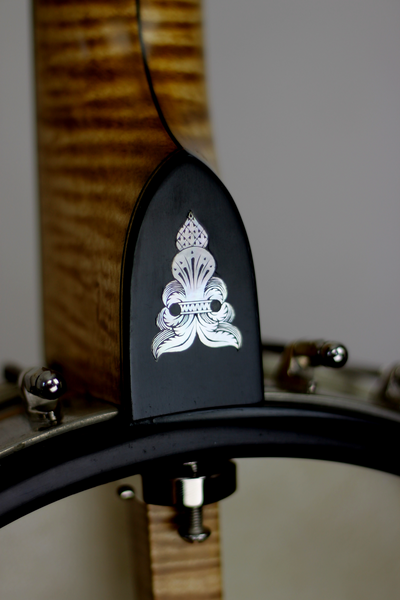 Heelcap Engraving
Heelcap EngravingThe heel cap inlay is also a classic Fairbanks design. Besides some specific requests on features and basic inlay patterns, my customer gave me freedom to make a number of creative choices so I was able to include details from some of my favorite 1890s to early 1900s Fairbanks-Vega banjos.
-
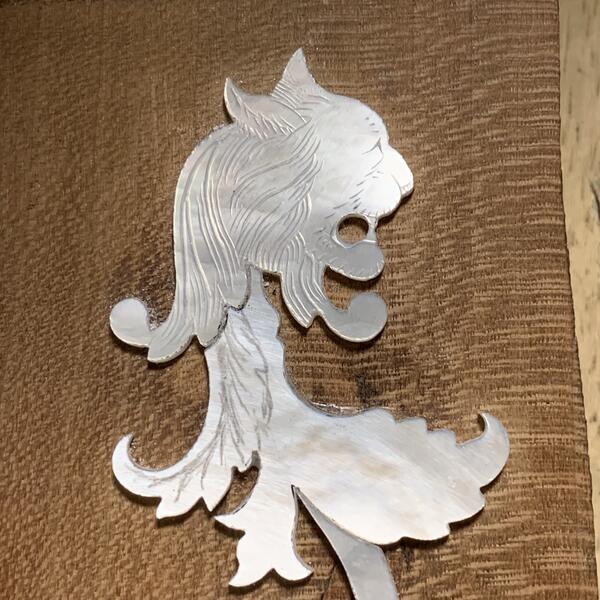 Process Shot of Engraving
Process Shot of EngravingThis process shot of the lion shows it after I have cut the pieces out of shell based on the pattern I made and glued onto a work surface. As you can see, I have cut some of the lines with the engraver and others are just being penciled in. This process takes a lot of planning and practice before committing to the final pieces.
-
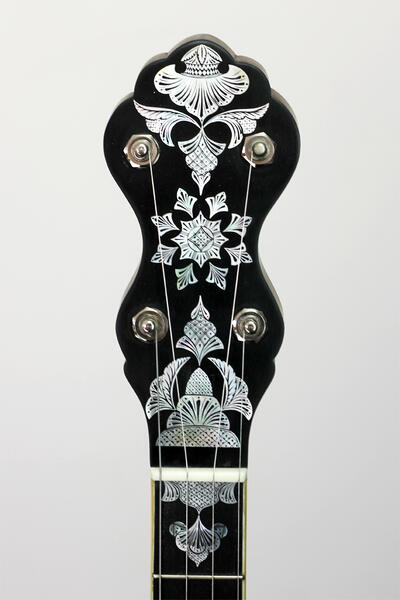 Cole Style Peghead
Cole Style PegheadThis pattern is based on one made by the Cole Banjo Company in the early 20th century. Each piece is a separately cut piece of abalone shell, engraved, and then inlaid into the ebony peghead.
-
AC Fairbanks Fern
This banjo has a fern design based on those made by AC Fairbanks and Company in the early 20th century.
Advocating for the Banjo and Its History
I began building early banjos to reconstructing something that at the time, we thought was lost to the historical record. I wanted to undo a historical injustice.
The story I often tell is that worked at Joe’s Record Paradise, a deep catalog record store in Silver Spring, and put on a copy of the Altamont: Black Stringboard Music From the Library of Congress album by mistake. Someone had misfiled it in the Blues section, where I often looked for obscure albums to play in the store, partially because I was curious and partially because I figured Blues would be inoffensive to the customers coming and going throughout the day. But it wasn’t Blues; it was Black string bands, it was Country music. Right away it put off my notions of who this music was performed by. I thought it was the whitest music ever and here were these black guys making really compelling music with it. The curiosity set in, and I started exploring the history of it. I've continued not only exploring the real, true history of the banjo and Black stringband music, but also sharing that history and knowledge across the country.
-
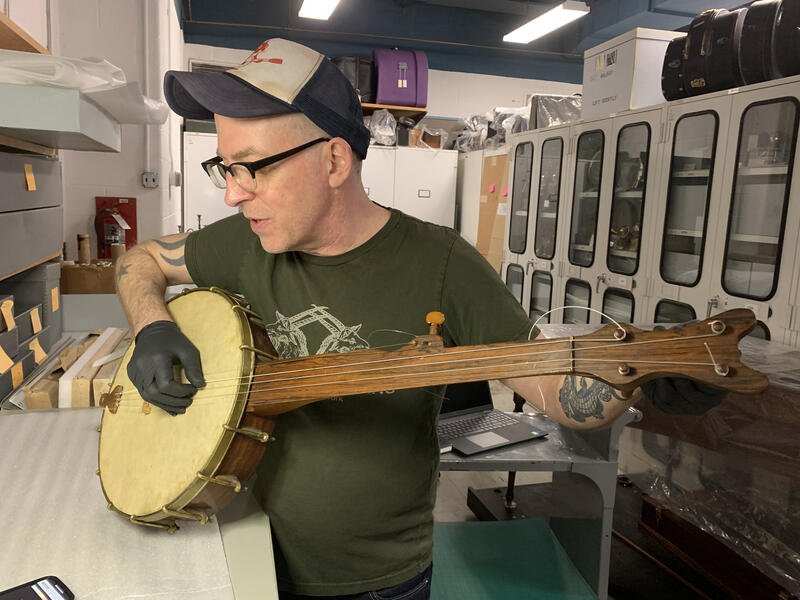 At the Smithsonian
At the SmithsonianIn 2023, I was invited to the Smithsonian Museum of American History to get one of their two historic William E. Boucher, Jr. banjos into playable condition so that MacArthur Fellow Rhiannon Giddens could play it in a concert. I have also consulted with the Museum of African American History and Culture on two banjos in their collection and built a banjo for the Museum of African American Music in Nashville.
-
Uncovering the History of the Banjo with Rhiannon Giddens: From African Roots to American Music
In 2022, Rhiannon Giddens invited me to be a guest on her series for Wondrium/ The Great Courses about the history of the banjo. I was able to share why this history is so important to me, and why it should be so important to all Americans. (Start at 8:04).
-
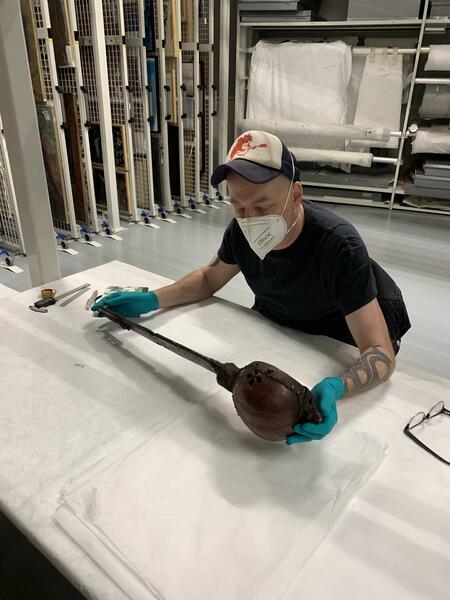 In Lyon, France, with an early banjo
In Lyon, France, with an early banjoIn early 2022, I was lucky enough to be invited to Lyon, France to examine a newly rediscovered early banjo. When I began my work, only one early, African American made banjo was known, and it was in a collection in the Netherlands. In 2004, a banjo was discovered at the Musee de la Musique in Paris, which had been collected in Haiti in 1841. In 2017, another banjo turned up in Germany, which had been collected in Suriname before 1851. I was shocked and amazed to receive an email in the fall of 2021 from the curator at the Musee de la Musique, in which he told me he thought an instrument in Lyon was a banjo. As soon as COVID travel restrictions allowed, I traveled to examine it-- having examined the other three. This type of research is not only vital to my banjo building, but our understanding of the instrument. The instrument is the only historic item we have from the people who created and played this instrument-- no other written or drawn records exist. This makes these instruments incredibly valuable and special.
-
My banjo on display
Here is the reproduction of the Lyon banjo I made for an exhibit at the Lyman Allyn Art Museum in New London, Connecticut. Having my banjo next to a West African Akonting allowed the curators to speak to the differences between African lutes and New World banjos, and how the banjo was the innovation of enslaved African Americans making a new culture for themselves.
My banjos have also been exhibited in the Museum of Musical Instruments, Brussels, Belgium; Musical Instrument Museum, Phoenix, Arizona; Colonial Williamsburg Foundation, Williamsburg, Virginia; George Washington Historical Birthplace National Park, Colonial Beach, Virginia; Blue Ridge Institute, Ferrum, Virginia; Appomattox State Courthouse National Park, Appomattox, Virginia; Mercer Museum, Pennsylvania; Hines History Center, Pittsburgh, Pennsylvania; National Museum of African American Music, Nashville, Tennessee; Lefferts Historic House, Brooklyn, New York; and the Crooked Trail Road, Galax, Virginia.
-
At the Baltimore Museum of Industry
In 2014, I co-curated “Making Music: The Banjo in Baltimore and Beyond” with Greg Adams and Robert Winans. The exhibit at the Baltimore Museum of Industry explored the mid- to -late nineteenth century Baltimore banjo maker William E. Boucher, Jr. and the transformation of the banjo to a commercial product. We also included one of my reproduction gourd banjos to show visitors what the banjo would have looked like on the tobacco plantations of Maryland in the 1750s to 1830s.
This WYPR piece about the exhibit explains how it came to be and why the banjo is important to Maryland history: https://www.wypr.org/show/the-signal/2014-07-22/the-banjos-twisted-history-the-washington-monuments-restoration-and-nick-sjostroms-i-am-ok
-
 At the 2019 National Folk Festival
At the 2019 National Folk FestivalIn 2019, I was invited to the National Folk Festival in Salisbury, Maryland to talk about my banjo building and Maryland's important banjo history. In addition to showing visitors how I make gourd banjos, I did a presentation and performance, showcasing some historic Black banjo music and explaining that some of the earliest records of the banjo in North America are from Maryland and the Chesapeake region.
-
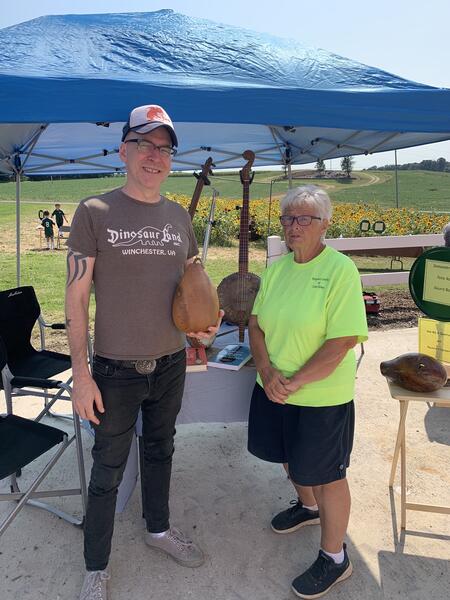 At the gourd festival
At the gourd festivalIn recent years, I've been working with a gourd grower in Baltimore County to get gourds to the specifications that work well for my instruments. As a gourd lover, Bobbie loves the art I am able to create with her gourds. She invited me to her gourd festival, where I was able to share my instruments with the public and share some of this important history.
-
Musicians Playing
One of the most pleasing things for me is getting gourd banjos in the hands of musicians, both amateur and professional. Professional musicians, including local Baltimore banjo powerhouse Brad Kolodner, use my instruments as a way to share a little bit about the instrument's history with their audiences. Here, Nora Brown and Kristina Gaddy are playing a gourd banjo and gourd fiddle I made.
-
2022 American Musical Instrument Society Meeting
I was invited to the American Musical Instrument Society meeting in Calgary, Canada in 2022 to discuss the physical attributes of gourd banjos and how they differ from African lutes.
-
Midwest Banjo Camp
I have also been invited by camps to teach 1850s banjo playing techniques (like in this video) and banjo building classes.

